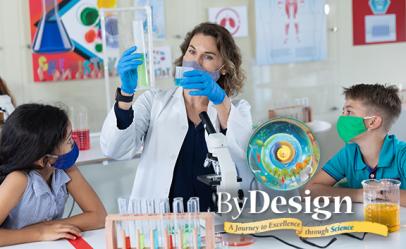 By: Kendall Hunt RPD with contributions from the writing team of By Design Science grades 1-8
By: Kendall Hunt RPD with contributions from the writing team of By Design Science grades 1-8
Teamwork makes the dream work.
Divide and conquer.
Alone we can do so little; together we can do so much.
Though these quotes may seem cliché, the sentiment underlying them couldn’t be more accurate— when we work together and pool our collective resources, we stand a much greater chance of reaching our goals and retaining what we learn along the way.
In the classroom, of course, those benefits are multiplied. According to the Center for Teaching Innovation at Cornell University, collaborative learning promotes higher-level thinking, self-regulation, and leadership skills. Plus, it can boost students’ self-esteem, broaden perspectives, and prepare them for real-world social and employment scenarios.
Group collaboration is an inherent aspect of our customized educational curricula here at Kendall Hunt Religious Publishing. In our ByDesign Science curriculum, for example, it’s right in the philosophy of the program: “ByDesign is built on a foundation of inquiry that encourages wonderment, questioning, exploration… and collaboration” (ByDesign Product Brochure). Especially during the Discover, Explain, and Extend phases of our five-step instructional model, teachers have ample opportunities to encourage group collaboration among young learners. Whether it’s working together to complete an Explore-A-Lab feature, discussing a Faith Connection or Scripture Spotlight in small groups, or partnering up to review key concepts at the end of a unit, ByDesign Science is designed for students to learn about God’s creation—together.
But in the world of COVID-19, of social distancing and remote or hybrid learning, how can students work together safely?
Here are three ways, adapted for both in-person and virtual classrooms, with references to ByDesign Science throughout.
Think-Pair-Share
Most educators have experience with the Think-Pair-Share model, where students ponder a question or problem individually, then discuss with a partner, then share their ideas with either a small group or the whole class. ByDesign Science asks students to follow this model when creating Know-Want-Learn (K-W-L) charts, for example, as well as during discussions of biblical connections.
Happily, the Think-Pair-Share model translates well to a virtual classroom, where teachers can utilize breakout rooms before bringing students back together to share their thoughts. For an in-person, socially distanced classroom, consider establishing stations around the room so that pairs can spread out while still reaping the benefits of collaborative discussion.
Wall of ideas
For students in a hybrid or alternate-day learning model, a wall of ideas can allow learners to connect with their peers who don’t go to school on the same day as they do. Teachers can write a question at the top of a whiteboard or paper-covered bulletin board, asking students to write their responses on the days they attend in-person school. Each day they return, their peers from the opposite day will have added new ideas.
ByDesign Science includes countless questions perfect for this type of activity. For example, students in Grade 4, when studying matter, are asked to list five classroom objects and describe their properties. As students add their ideas to the list, they’ll connect with their peers and get a taste of collaborative learning!
Jigsaw exercises
Jigsaw exercises, like the puzzles from which they take their name, require students to put together the pieces to understand the full picture of an issue or topic. These types of activities are perfect for remote learners because each learner can work on his or her own topic and then become the “expert” of the group.
ByDesign Science incorporates activities that are either already designed as jigsaw exercises or can easily be adapted to fit this model. For example, in Grade 6, young scientists are asked to research images of epithelial, connective, muscle, and nerve tissue on the Internet and then compare them. Teachers in a virtual classroom can divide students into breakout rooms of four each, where each student will select a type of tissue to investigate. Then, they’ll share their knowledge with the rest of the group to fill in the “missing pieces” of their jigsaw puzzle of learning.
Like all aspects of education, collaborative learning has changed in COVID-19 times. How have you encouraged your students to work together during the pandemic, whether in-person or virtually?
Sources:
https://teaching.cornell.edu/teaching-resources/engaging-students/collaborative-learning),
https://www.flashpointleadership.com/blog/5-collaborative-learning-techniques-to-try-in-your-next-virtual-workshop-or-with-your-team